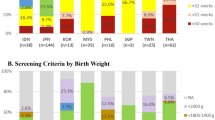Abstract
The aim of this study is to evaluate current anaesthetic practice for retinopathy of prematurity (ROP) interventions in the UK. We collected the data from the 12-month prospective British Ophthalmic Surveillance Unit study carried out in 2013/2014 that were analysed with regard to type of anaesthesia used for primary ROP procedures and the hospital department in which treatment took place. A total of 327 cases of treated ROP from 55 different UK units were reported in the study. Type of anaesthesia used during treatment was available for 324 (99.1%) cases and the treatment location in 316 (96.6%). Overall, 266 (89.3%) laser treatments and 13 (50.0%) of primary intravitreal injections were performed with the neonate intubated, using intravenous sedation (IVS) in 158 (59.4%) and the remainder, under general anaesthesia (GA). Two hundred thirteen (67.4%) of all ROP procedures took place in the neonatal unit. GA was used in 98 (95.1%) of theatre cases compared with 19 (8.9%) of cases treated in the neonatal unit. Three (0.9%) neonates suffered significant respiratory distress during or immediately after laser treatment.
Conclusion: This survey suggests that the preference in UK units is to undertake ROP laser treatment in the neonatal unit with the neonate intubated and sedated intravenously. Those babies treated in the operating theatre are more likely to receive GA. In the surveyed year, half of the neonates receiving intravitreal injections as sole primary therapy was intubated; the reason for this could not be elucidated from the responses. Adverse respiratory reactions during or after laser treatment affected fewer than 1% of the neonates in this study.
What is Known: • Prior to the introduction of intravitreal anti-VEGF, almost all ROP treatments in the UK were performed under general anaesthetic (GA). • The technique of intravitreal injection is described using topical anaesthesia and was thought to be changing anaesthesia preferences for ROP treatment. What is New: • Half of the neonates receiving primary anti-VEGF injection in the UK were treated under intravenous sedation or GA. • The increasing use of primary anti-VEGF treatment has not influenced trends in anaesthetic practice in the UK since the last review 10 years ago. |


Similar content being viewed by others
Abbreviations
- APROP :
-
Aggressive posterior retinopathy of prematurity
- BOSU :
-
British Ophthalmic Surveillance Unit
- GA :
-
General anaesthetic
- ROP :
-
Retinopathy of prematurity
- IVS :
-
Intravenous sedation
- NICU :
-
Neonatal intensive care unit
- S/T :
-
Sub-Tenon anaesthesia with oral or rectal sedation and analgesia without intubation
- VEGF :
-
Vascular endothelial growth factor
References
Blencowe H, Moxon S, Gilbert C (2016) Update on blindness due to retinopathy of prematurity globally and in India. Indian Pediatr 53(Suppl 2):S89–S92
Blencowe H, Vos T, Lee ACC, Philips R, Lozano R, Alvarado MR, Cousens S, Lawn JE (2013) Estimates of neonatal morbidities and disabilities at regional and global levels for 2010: introduction, methods overview, and relevant findings from the global burden of disease study. Pediatr Res 74(Suppl 1):4–16
Adams GGW et al (2017) Can we reduce the burden of the current UK guidelines for retinopathy of prematurity screening? Eye (Lond)
Adams GG et al (2017) Treatment trends for retinopathy of prematurity in the UK: active surveillance study of infants at risk. BMJ Open 7(3):e013366
Chen SD et al (2007) Variation in anaesthesia for the laser treatment of retinopathy of prematurity--a survey of ophthalmologists in the UK. Eye (Lond) 21(8):1033–1036
Novitskaya ES, Kostakis V, Broster SC, Allen LE (2013) Pain score assessment in babies undergoing laser treatment for retinopathy of prematurity under sub-tenon anaesthesia. Eye (Lond) 27(12):1405–1410
Anand D, Etuwewe B, Clark D, Yoxall CW (2007) Anaesthesia for treatment of retinopathy of prematurity. Arch Dis Child Fetal Neonatal Ed 92(2):F154–F155
Jiang JB, Strauss R, Luo XQ, Nie C, Wang YL, Zhang JW, Zhang ZW (2017) Anaesthesia modalities during laser photocoagulation for retinopathy of prematurity: a retrospective, longitudinal study. BMJ Open 7(1):e013344
(2008) Royal College of Paediatrics and Child Health, Royal College of Ophthalmologists British Association of Perinatal Medicine & BLISS:Guideline for the Screening and Treatment of Retinopathy of Prematurity
Mintz-Hittner HA, Kuffel RR Jr (2008) Intravitreal injection of bevacizumab (avastin) for treatment of stage 3 retinopathy of prematurity in zone I or posterior zone II. Retina 28(6):831–838
Acknowledgments
We wish to thank the British Ophthalmic Surveillance Unit, in particular, Mr. Barny Foot, for collection of case notifications. We thank Ms. Anneka Tailor for liaising with practitioners across the UK to facilitate data collection and completion of reports and for maintaining the study database. We thank Mr. Zabed Ahmed for setting up a comprehensive electronic database.
Author information
Authors and Affiliations
Contributions
E Novitskaya analysed the data, drafted and revised the manuscript. Annegret H Dahlmann-Noor and Gillian G W Adams collected the data through BOSU study and revised the manuscript. L Allen critically revised the manuscript and supervised the writing of the manuscript. All authors reviewed and discussed and interpreted the data acquired. All authors gave final approval.
Corresponding author
Ethics declarations
Conflict of interest
The authors declare that they have no conflict of interest.
Ethical approval
This article does not contain any studies with human participants or animals performed by any of the authors. The study was approved by the Research Ethics Committee North of Scotland, Aberdeen (13/NS/0059).
Additional information
Communicated by Daniele De Luca
Publisher’s note
Springer Nature remains neutral with regard to jurisdictional claims in published maps and institutional affiliations.
Rights and permissions
About this article
Cite this article
Novitskaya, E.S., Dahlmann-Noor, A.H., Adams, G.G.W. et al. Retinopathy of prematurity treatment in the UK: trends in neonatal anaesthetic support and location of treatment from a national surveillance study. Eur J Pediatr 179, 1603–1607 (2020). https://doi.org/10.1007/s00431-020-03650-3
Received:
Revised:
Accepted:
Published:
Issue Date:
DOI: https://doi.org/10.1007/s00431-020-03650-3




